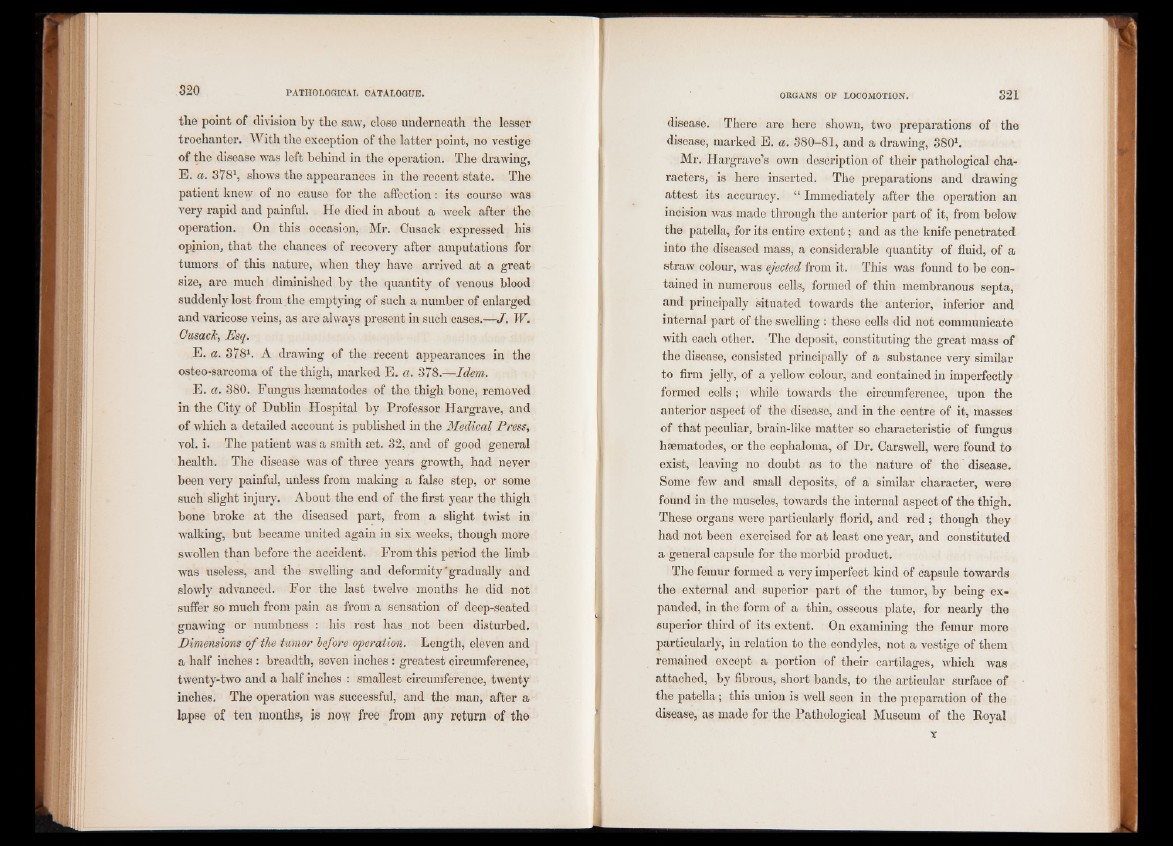
the point of division by the saw, close underneath the lesser
trochanter. With the exception of the latter point, no vestige
of the disease was left behind in the operation. The drawing,
E. a. 3781, shows the appearances in the recent state. The
patient knew of no cause for the affection: its course was
very rapid and painful. He died in about a week after the
operation. On this occasion, Mr. Cusack expressed his
opinion, that the chances of recovery after amputations for
tumors of this nature, when they have arrived at a great
size, are much diminished by the quantity of venous blood
suddenly lost from the emptying of such a number of enlarged
and varicose veins, as are always present in such cases.—J. W.
GusacJc, Esq.
E. a. 3781. A drawing of the recent appearances in the
osteo-sarcoma of the thigh, marked E. a. 378.—Idem.
E. a. 380. Fungus hsematodes of the thigh bone, removed
in the City of Dublin Hospital by Professor Hargrave, and
of which a detailed account is published in the Medical Press,
vol. i. The patient was a smith set. 32, and of good general
health. The disease was of three years growth, had never
been very painful, unless from making a false step, or some
such slight injury. About the end of the first year the thigh
bone broke at the diseased part, from a slight twist in
walking, but became united again in six weeks, though more
swollen than before the accident. From this period the limb
was useless, and the swelling and deformity'gradually and
slowly advanced. For the last twelve months he did not
suffer so much from pain as from a sensation of deep-seated
gnawing or numbness : his rest has not been disturbed.
Dimensions of the tumor before operation. Length, eleven and
a half inches : breadth, seven inches : greatest circumference,
twenty-two and a half inches : smallest circumference, twenty
inches. The operation was successful, and the man, after a
lapse of ten months, is now free from any return of the
disease. There are here shown, two preparations of the
disease, marked E. a. 380-81, and a drawing, 3801.
Mr. Hargrave’s own description of their pathological characters,
is here inserted. The preparations and drawing
attest its accuracy. “ Immediately after the operation an
incision was made through the anterior part of it, from below
the patella, for its entire extent; and as the knife penetrated
into the diseased mass, a considerable quantity of fluid, of a
straw colour, was ejected from it. This was found to be contained
in numerous cells, formed of thin membranous septa,
and principally situated towards the anterior, inferior and
internal part of the swelling : these cells did not communicate
with each other. The deposit, constituting the great mass of
the disease, consisted principally of a substance very similar
to firm jelly, of a yellow colour, and contained in imperfectly
formed cells; while towards the circumference, upon the
anterior aspect of the disease, and in the centre of it, masses
of that peculiar, brain-like matter so characteristic of fungus
haematodes, or the cephaloma, of Dr. Carswell, were found to
exist, leaving no doubt as to the nature of the disease.
Some few and small deposits, of a similar character, were
found in the muscles, towards the internal aspect of the thigh.
These organs were particularly florid, and red; though they
had not been exercised for at least one year, and constituted
a general capsule for the morbid product.
The femur formed a very imperfect kind of capsule towards
the external and superior part of the tumor, by being expanded,
in the form of a thin, osseous plate, for nearly the
superior third of its extent. On examining the femur more
particularly, in relation to the condyles, not a vestige of them
remained except a portion of their cartilages, which was
attached, by fibrous, short bands, to the articular surface of
the patella; this union is well seen in the preparation of the
disease, as made for the Pathological Museum of the Royal
Y